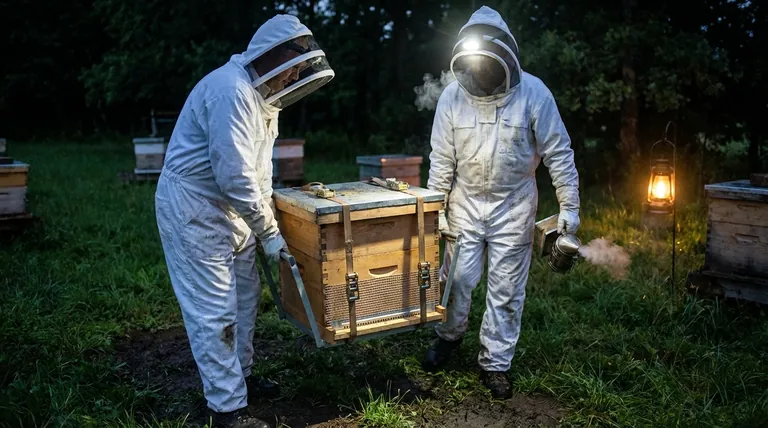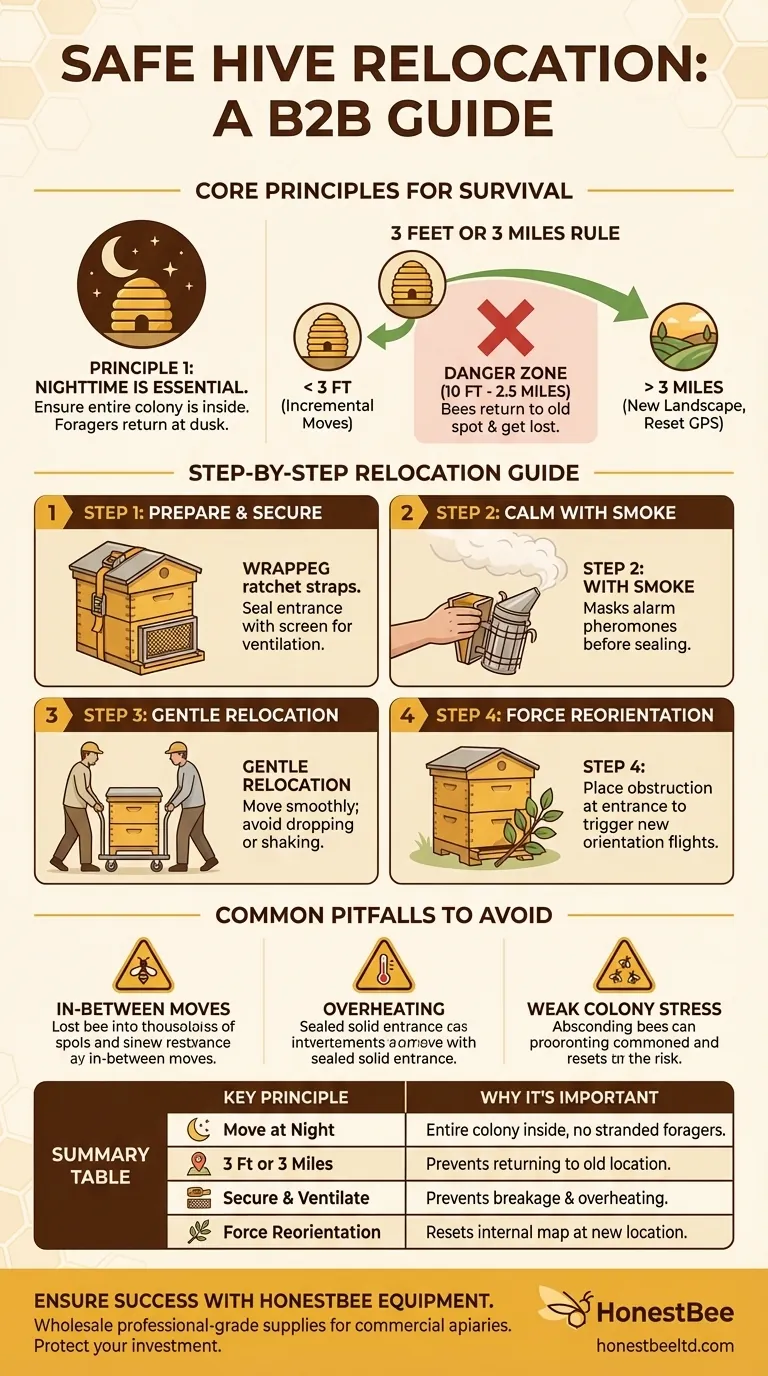To move a beehive without killing the bees, you must do it at night when the entire colony is inside and follow the "3 feet or 3 miles" rule. This principle ensures the bees either don't notice the small change or are forced to completely reorient to a new landscape, preventing them from getting lost and returning to the hive's old location. The process involves securing the hive, moving it gently, and helping the bees reorient upon arrival.
The single most critical factor in a successful hive move is respecting the bees' navigational biology. Moving a hive less than 3 feet or more than 3 miles away prevents forager bees from returning to the old location, getting lost, and perishing.

The Core Principles of a Safe Hive Move
Successfully relocating a colony is less about brute force and more about understanding and working with bee behavior. Two principles are non-negotiable for the colony's survival.
Why Nighttime is Essential
Foraging bees spend the day collecting pollen and nectar, often miles from the hive. At dusk, they all return to the colony for the night.
Moving a hive during the day will strand thousands of forager bees. By waiting until after dusk or acting before dawn, you ensure the entire population is safely enclosed for the journey.
The "3 Feet or 3 Miles" Rule
This is the golden rule of moving bees and is based on their internal GPS.
- Less than 3 feet: A very short move (e.g., from one side of a garden bed to the other) is a small enough change that the bees will notice it upon exiting the hive and reorient themselves locally. This is best done in small increments over several days.
- More than 3 miles: A long-distance move places the hive in a completely new environment. The new landscape is so unfamiliar that it triggers the bees to perform new orientation flights, effectively resetting their internal map to the new location.
Any distance between these two—from 10 feet to 2.5 miles—is the danger zone. Bees will return to the exact original spot, become confused and disoriented when the hive isn't there, and eventually die.
Step-by-Step Guide to Moving Your Hive
With the core principles understood, the physical process is straightforward. Preparation is everything.
Step 1: Prepare and Secure the Hive
The night before the move, after all bees have returned, suit up and approach the hive.
Use ratchet straps to bind all the hive components together—bottom board, brood boxes, supers, and lid. This prevents the hive from shifting or falling apart during transport.
Once strapped, you must seal the entrance. Use a dedicated entrance block or a piece of #8 hardware cloth (screen) folded and tucked into the entrance. A screen is ideal as it prevents escape while still allowing for ventilation.
Step 2: Use Smoke to Manage Stress
As noted by beekeepers, a small amount of smoke is a powerful tool for calm. When a hive is disturbed, guard bees release an alarm pheromone.
A few gentle puffs of cool, white smoke at the entrance before you seal it masks this pheromone. This interruption prevents a full-scale alarm and keeps the colony in a calmer, more manageable state.
Step 3: Perform the Relocation
With the hive secured and sealed, it is ready to move. Use a dolly, wheelbarrow, or a partner to help you lift.
The key is to be smooth and gentle. Avoid jarring or dropping the hive, as this can dislodge frames, crush bees, and damage the comb.
Step 4: Re-open and Orient the Hive
Once at the new location, place the hive and unseal the entrance. Do not simply open it and walk away.
To force reorientation, place an obstruction in front of the entrance, like a leafy branch or a board leaning against the front. This forces the bees to slow down, notice the change, and perform new orientation flights as they emerge in the morning. Remove the branch after a day or two.
Common Pitfalls to Avoid
Even a well-planned move has risks. Understanding them helps you mitigate them.
The Danger of "In-Between" Moves
It cannot be overstated: moving a hive 500 feet across your property is often more dangerous than moving it 5 miles away. Do not attempt it in one go. If you must make an intermediate move, the safest method is to first move the hive >3 miles away for 2-3 weeks, then move it back to the new, desired spot.
Overheating and Ventilation
A sealed hive can quickly overheat, especially in warm weather. This is why using a screened entrance is far superior to a solid block. Never leave a hive fully sealed for an extended period during a hot day.
Colony Stress
A move is inherently stressful. A weak hive may not handle the stress well and could be at risk of absconding (abandoning the hive). Ensure your colony is strong and healthy before attempting a relocation.
Making the Right Choice for Your Move
Your strategy depends entirely on the distance.
- If your primary focus is a short-distance move (in the same yard): Move the hive in increments of 3 feet or less every few days until it reaches its final destination.
- If your primary focus is a long-distance move (to a new property): Ensure the new location is over 3 miles away and complete the move in a single night.
- If your primary focus is an intermediate-distance move (e.g., 200 yards): The only truly safe method is to move the hive >3 miles away for a few weeks, then move it back to its final position, treating the return as a new long-distance move.
By respecting the colony's biology and following these careful steps, you can ensure your bees arrive at their new home safely and thrive.
Summary Table:
| Key Principle | Why It's Important |
|---|---|
| Move at Night | Ensures the entire colony is inside the hive, preventing foragers from being stranded. |
| The '3 Feet or 3 Miles' Rule | Prevents bees from returning to the old location and getting lost. Distances in between are dangerous. |
| Secure & Ventilate the Hive | Ratchet straps and a screened entrance prevent the hive from breaking apart and overheating during the move. |
| Force Reorientation | Placing an obstruction like a branch at the new entrance helps bees reset their internal GPS to the new location. |
Ensure Your Next Hive Relocation is a Success with the Right Equipment
Moving a hive is stressful for both you and your bees. Having reliable, professional-grade equipment is crucial for a smooth and safe operation. HONESTBEE supplies commercial apiaries and beekeeping equipment distributors with the durable, wholesale-focused supplies needed for successful hive management.
From secure ratchet straps and ventilation screens to essential tools for hive maintenance, we provide the foundation for a thriving apiary.
Let us help you protect your investment. Contact our team of experts today to discuss your wholesale equipment needs and ensure your next move is flawless.
Visual Guide

Related Products
- HONESTBEE Advanced Ergonomic Stainless Steel Hive Tool for Beekeeping
- Professional Dual-End Stainless Steel Hive Tool for Beekeeping
- Professional Galvanized Hive Strap with Secure Locking Buckle for Beekeeping
- Professional 3-Bar Frame Grip with Integrated Hive Tool
- Professional Pneumatic Wire Embedder for Beehive Frames
People Also Ask
- How should beekeepers handle bees when using a hive tool? Master Calm, Deliberate Techniques
- What is the hole in a hive tool for? A Multi-Tool for Apiary Repairs and Maintenance
- What are the basic tools for beekeeping? Essential Starter Kit for Safe & Successful Hive Management
- How is a hive tool used for scraping and cleaning? Master Hive Maintenance for a Healthy Colony
- What is a hive tool and what are its uses? Master Your Hive Inspections with the Essential Beekeeper's Tool



















